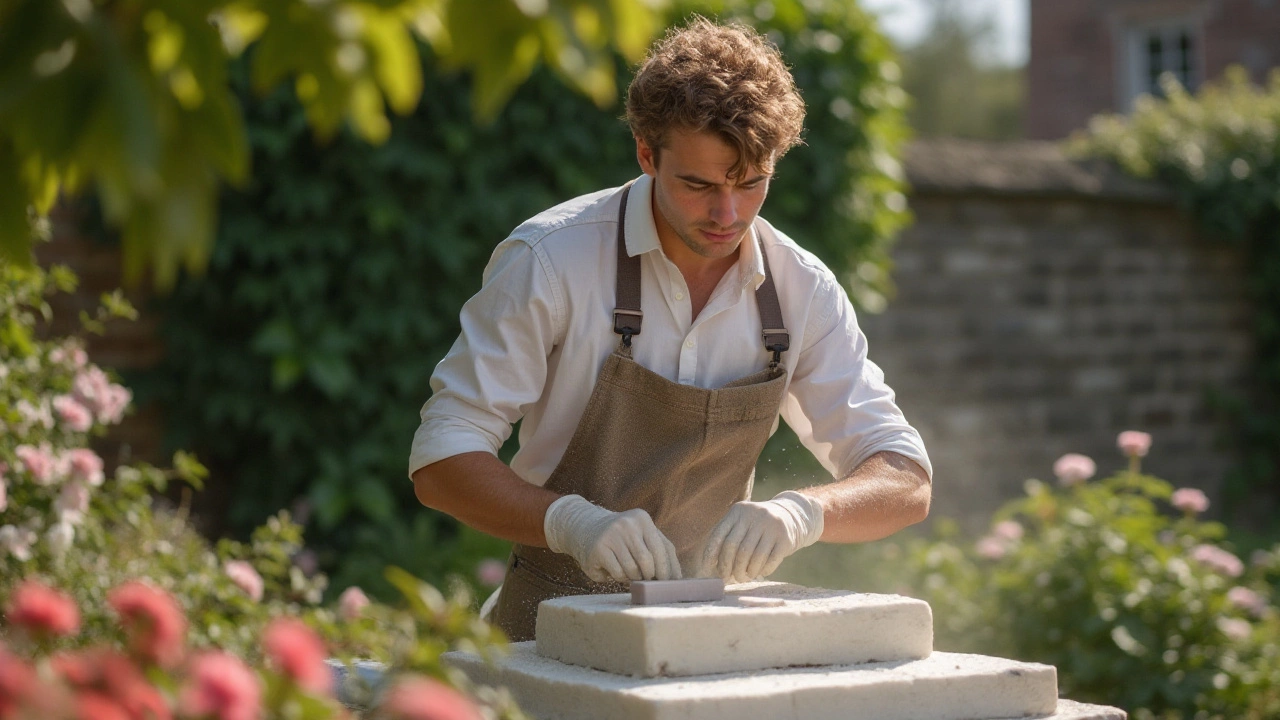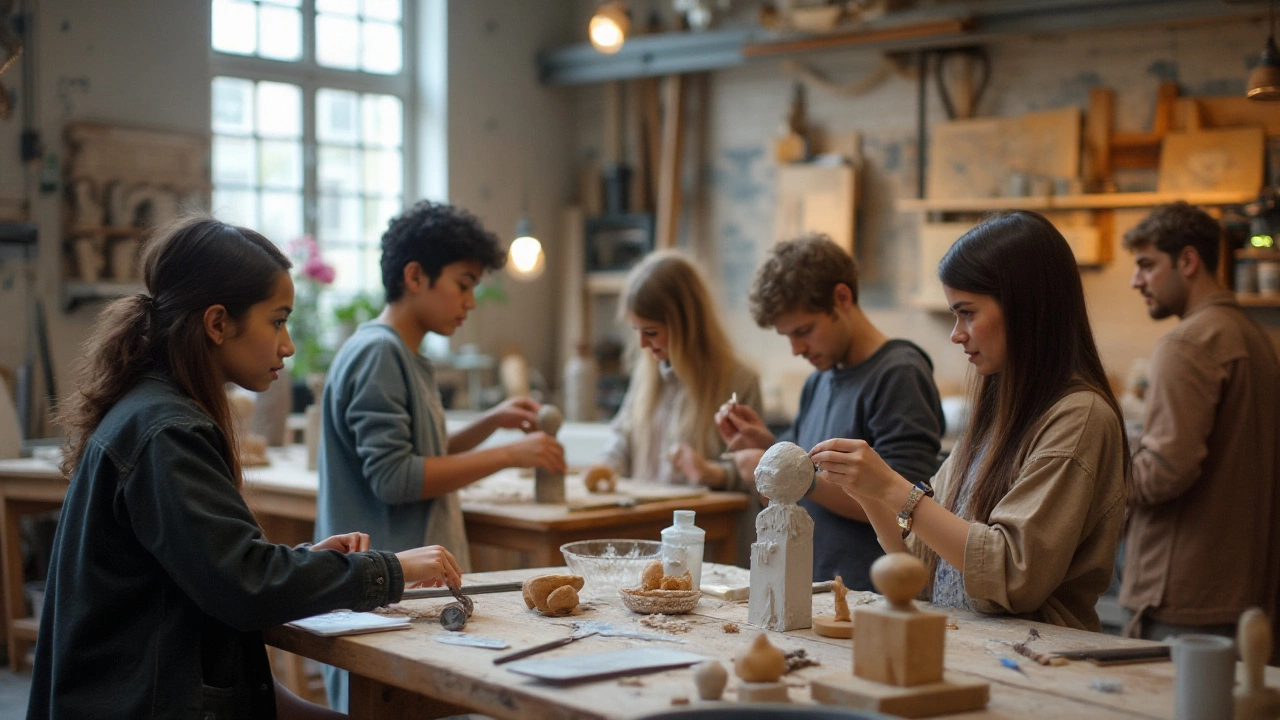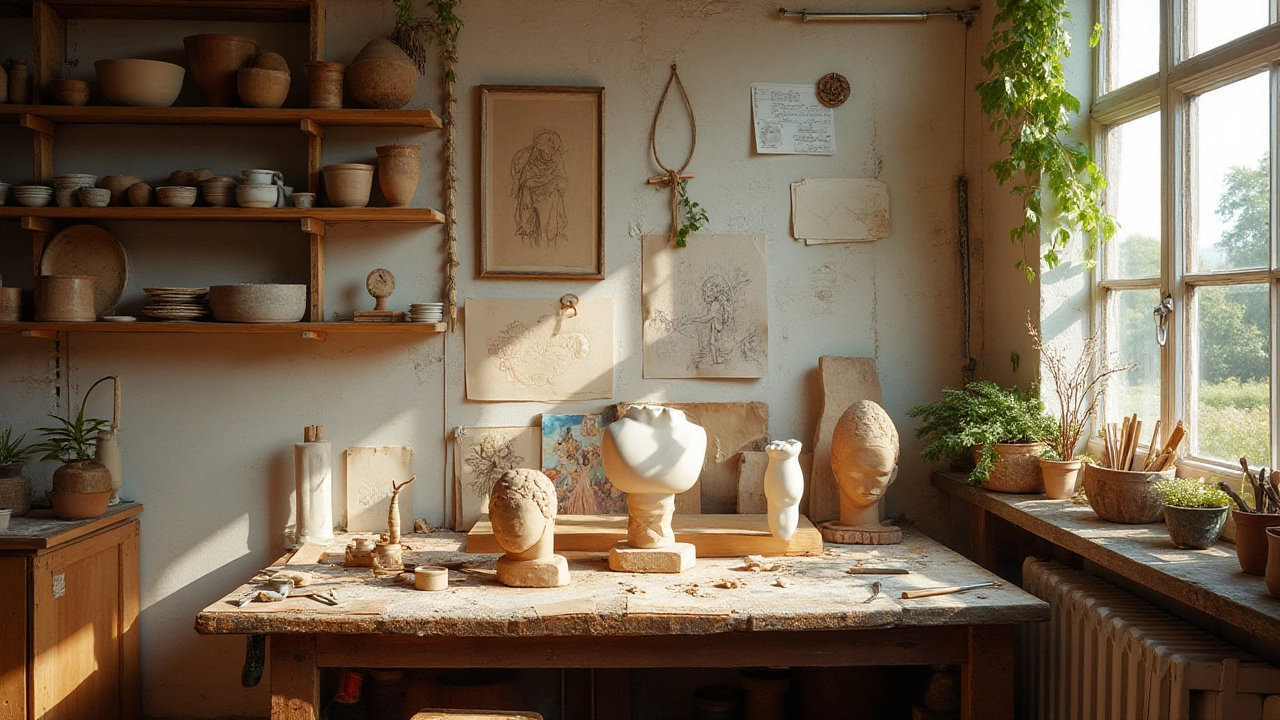Diving into the world of sculpture is like stepping into an endless realm of creativity—it offers a unique way to express emotions, ideas, and stories through tangible forms. Whether working with clay, stone, or metal, the art of sculpture challenges both the mind and the hands, promising a journey filled with discovery and fulfillment.
Beginners often wonder where to start, and that's precisely why understanding the basic principles and tools of sculpture is crucial. From selecting the right materials to knowing the various techniques and setting up a comfortable workspace, each step is an integral part of your artistic evolution. Let us walk together through the first steps of this timeless and ever-evolving craft.
- Understanding Sculpture Basics
- Choosing Your Materials
- Exploring Techniques
- Setting Up Your Workspace
- Finding Inspiration
Understanding Sculpture Basics
Exploring the fundamental elements of sculpture is akin to unlocking the secrets of one of the most ancient art forms known to humankind. Sculpting dates back thousands of years, with primitive artists shaping materials like clay and stone to communicate stories and beliefs long before the written word existed. This profound connection to history often inspires newcomers to the art form to not only pursue a hobby but to engage in a deeply expressive practice that echoes through the annals of time. When one begins their journey into sculpture, it is essential to grasp the types of materials used and their properties. The choices range from clay, known for its versatility and accessibility, to the timeless allure of marble, which requires patience and skill to carve. Each material offers its own unique challenges and rewards, prompting artists to explore how different substances can bring their visions to life.
Types of Sculpture
The realm of sculpture can be divided into several primary categories, each with its own techniques and tools. These include additive methods, such as clay modeling or assemblage, where materials are added or combined. In contrast, subtractive methods involve removing material, seen commonly in stone or wood carving. There is also casting, a process typically used with metals where the material is poured into a mold before being set. Each method provides a distinct tactile experience and outcome, challenging artists to adapt their skills accordingly. Understanding these techniques is crucial for beginners as it informs the entire sculpting process, influencing not only how a piece begins but how it evolves over time.
As you embark on your artistic journey, remember that sculpture is not solely about the hands that mold or carve. It is as much an intellectual challenge as it is a physical one. The ability to conceptualize a three-dimensional form from a mental image requires keen spatial awareness and creative problem-solving. Many new sculptors find themselves immersed in this mental exercise, as each block, curve, and texture must be precisely considered to manifest the intended outcome.
"The essence of sculpture is a balance between thought and action, perception and imagination," says acclaimed sculptor Barbara Hepworth, emphasizing the artistic interplay inherent in the craft.
The Influence of History and Culture
Sculpture has been shaped by the diverse cultures from which it emerged. From the ancient Egyptian statues that depicted gods and pharaohs to the dynamic and emotive works of Michelangelo during the Renaissance, each era has left its indelible mark on the art form. Even in contemporary times, sculpture continues to evolve, often serving as a commentary on societal change or personal expression. By studying these historical contexts, beginners can gain a deeper appreciation and understanding of how their own work fits within the broader tapestry of the art world.
While it might initially feel daunting, understanding these basics not only provides a foundational knowledge to make informed decisions about materials and techniques but also empowers artists to develop their unique voice within the tradition. As you begin your journey, immersing yourself in both practice and theory will enrich your experience and fuel the creative flame that drives every great sculptor forward.
Choosing Your Materials
When venturing into the world of sculpture, selecting the right materials is a vital decision that can significantly influence your creative process and the final artwork. Each material carries its own unique properties and challenges, which will dictate your technique and tools. The most common materials for beginner sculptors include clay, stone, wood, and metal, and each offers a different tactile experience and aesthetic. Let's delve into each of these materials, exploring their characteristics, advantages, and drawbacks to help you find the perfect fit for your artistic vision.
Clay is often the starting point for many beginners due to its versatility and ease of manipulation. It allows for experimentation, as it is forgiving and can be molded and reworked effortlessly. Clay ranges from soft, air-dry types to more resilient options like ceramic clay, which requires firing in a kiln. Each type of clay serves different artistic purposes, and selecting the right one can enhance your sculpting experience. According to a renowned sculptor, "Clay is like the breath of life for sculptors; it brings your imagination into physical form." This material is excellent for creating detailed and complex shapes, making it popular among both amateurs and seasoned artists.
Stone, on the other hand, is considered the 'classic' sculpting medium, ingrained in history and renowned for its durability and timelessness. Sculpting stone demands more patience and physical effort, as it requires removing rather than adding material. It offers a different artistic challenge, where every chisel stroke must be carefully calculated. Popular stone types include marble, soapstone, and limestone, each varying in hardness and workability. Sculpting in stone can bring an unmatched elegance and permanence to your pieces, but ensure you have the right tools and safety equipment to tackle it without injury.
Wood carving is another traditional approach, appreciated for its warmth and organic qualities. Different woods like oak, maple, and balsa provide unique grains and textures, which can complement or challenge the sculptor's intent. Wood is relatively softer than stone, allowing more flexibility in form but still requiring sharp tools and skillful precision. An essential consideration when working with wood is the ability to preserve its natural beauty while also respecting its limitations and strengths.
"A sculpture is just a block of stone until a masterfully guided tool unleashes its potential," a celebrated artist once remarked, emphasizing the importance of understanding your medium.
Metal sculptures exhibit a modern elegance and industrial vibe, often created through techniques like welding, casting, or forging. Metals like bronze and steel provide strength and a variety of finishing options, but they also necessitate advanced skills and equipment. Working with metals requires an understanding of their response to heat and pressure, making it a better option for those already comfortable with basic sculpting principles.
Navigating through the sea of materials is a journey in itself. As you contemplate which medium to embrace, consider your personal interests, the message you wish to convey, and the level of durability required in your work. Don't shy away from experimenting with multiple materials, as this experimentation expands your creative toolbox and hones your ability to adapt different techniques across mediums. For those eager to explore stats and facts, here's a simple yet telling comparison of materials:
| Material | Ease of Use | Cost | Durability |
|---|---|---|---|
| Clay | High | Low | Moderate |
| Stone | Low | High | High |
| Wood | Medium | Variable | Moderate |
| Metal | Low | High | Very High |
Choosing the right material sets the foundation for your sculpture journey, aligning your creative objectives with the physical capabilities of your medium. Investigating each material's nuances invites you into a deeper relationship with your artistry, where you're not just crafting forms but also exploring the essence and endurance of your chosen medium.

Exploring Techniques
Sculpture, an enduring form of art, has evolved through time with remarkable techniques that challenge an artist’s skills and creativity. The journey into sculpture techniques starts with understanding the three-dimensional nature of this art form. Unlike paintings that confine themselves to a canvas or drawings limited to two dimensions, sculptures exist in real space, inviting viewers to engage from different perspectives. Beginners often find this aspect both thrilling and daunting. Mastering a technique means embracing mistakes as part of the learning curve, allowing each piece to guide the hands with experience.
The first technique aspiring artists often encounter is modeling, generally using pliable materials like clay or wax. These materials allow sculptors to add or subtract easily, refining their pieces over time. Clay modeling, a favored technique, is particularly accessible for beginners. Clay can be reshaped, softened, or hardened, offering an adaptable medium for experimenting with forms and figures. As renowned sculptor Henry Moore aptly noted, "The important thing is somehow to begin."
Beneath the surface of any profound masterpiece lies countless hours of trial and error, emphasizing the enduring patience essential in sculpture.
Carving, another iconic technique, brings a sculptor closer to the traditional roots of the art. This method typically involves chiseling away at materials such as stone or wood. Each thud of the chisel against stone or slice through wood demands precision and forethought. Stone carving, in particular, requires understanding the grain and weaknesses of the material. David, one of the most recognizable marble sculptures by Michelangelo, stands testament to the power of carving techniques—transforming a stone block into an eternal symbol of beauty. The technique requires meticulous planning, as the process is subtractive, unlike modeling. Once a section is carved away, it's gone for good, highlighting the permanence of decisions made during creation.
Assemblage, adopting a more contemporary approach, involves creating sculptures from various found objects and materials. This technique encourages artists to view everyday items through a creative lens, transforming them into parts of a whole masterpiece. It acts almost as a playground of ideas, enabling sculptors to mix and match elements to suit personal themes and narratives. Jean Dubuffet, a champion of assemblage, once expressed that his chaotic yet expressive sculptures speak to the imagination’s limitless potential. In today's world, where sustainability is emphasized, assemblage also aligns with environmentally conscious practices, repurposing what may have been discarded.
Casting, a technique that allows for the replication of a sculpture, adds another dimension to the sculptor's toolbox. Often used in metalwork, casting involves creating a mold of the original sculpture and pouring material into it. This technique not only enables artists to produce multiple versions of their work but also brings out details that might be lost with other methods. The Roman and Greek art eras made extensive use of casting, especially in bronze sculptures, accentuating their craftsmanship and grandeur. Whether replicas or original works, casting preserves a piece's essence, solidifying the artist's intent into a durable form.
Each technique reflects its unique challenges and rewards, deeply influencing the outcome of a piece. Choosing a method often involves aligning personal artistic goals with available resources and skills. Aspiring sculptors can also look to various workshops and mentor-led sessions to gain firsthand experience. At times, merging techniques might yield unexpected results, combining the fluidity of clay with the stark enthrallment of stone or the rugged allure of assemblage. As artists grow, their choice of techniques will often evolve, mirroring their growth and exploration within the boundless landscape of sculpting. Within this vast domain, every type of sculpture holds potential, eagerly waiting to be unfolded, modeled, carved, assembled, or cast by passionate hands.
Setting Up Your Workspace
Creating the ideal environment for sculpting is a step you should not underestimate. It does not merely involve having space to hold your materials but also ensuring this place breeds creativity and productivity. As a beginner, your workspace should be a sanctuary where you feel inspired and undistracted. The type of material you decide to work with greatly influences your workspace needs. For instance, if you’re using clay, humidity and temperature control might be more critical, whereas working with stone may demand strong, stable surfaces for chiseling.
A vital decision revolves around the actual placement of your workspace, be it a dedicated studio or a quiet corner in your home. Lighting plays an essential role; natural light often offers the best clarity and mood, so consider setting up near a window. However, supplement with spotlights to highlight details when ambient light fades. Tools need organization to maintain workflow; thus, investing in shelving or pegboards can keep them visible and within reach. Having a defined space for every tool helps in cultivating a disciplined artistic process.
Safety in your workspace should be a priority from the outset. Dust and particles can become hazardous, especially when working with materials that shed. Implement adequate ventilation through windows or exhaust fans, ensuring your area remains fresh and healthy. Many seasoned sculptors advocate for wearing protective gear like masks and safety goggles. As the celebrated sculptor Augustus Saint-Gaudens suggested, "The safety of workmen is a first consideration. Without it, art cannot flourish."
Incorporating technology can vastly enhance the way you interact with your art. Computers or tablets for digital sculpting references can provide new perspectives and techniques that can be translated to physical art. Additionally, a music system might help in keeping your creativity flowing; some sculptors swear by the rhythmic benefits of working to their favorite tunes.
In some instances, numerical data might further assist in setting up your sculpting haven. According to a survey by the National Endowment for the Arts, artists noted a 40% increase in productivity when they engaged with their craft in a personalized space. This statistic underlines how crucial customization is. Ultimately, your workspace should echo your artistic vision, filled with elements that encourage every stroke and carve, pushing the boundaries of what you can create.

Finding Inspiration
Embarking on a journey to discover inspiration for your next sculpture can be as exciting as the creative process itself. Many aspiring artists find that the world around them offers a wealth of potential ideas, waiting to be transformed into tangible forms. Nature, for instance, is a classic muse—with its endless array of shapes, textures, and colors, it provides a rich tapestry from which many have drawn motivation. Walking through a quiet forest or observing the rhythmic waves of the ocean can evoke emotions and spark thoughts, leading you to create truly unique pieces.
Traveling to art museums or galleries is another excellent way to ignite the creative spark. By immersing yourself in the works of renowned artists and diverse artistic styles across history, you not only gain insight into different techniques, but you also broaden your creative horizon. It's said that variety is the spice of life, and coming into contact with a range of art forms can open your mind to new possibilities and combinations that might have otherwise remained unexplored.
Sometimes, inspiration comes from personal experiences or emotions. Reflecting on your own life, the challenges and triumphs you've faced, can lead to profoundly personal art that conveys deep, human stories. Journaling is a helpful way to hone in on these ideas—sketching little designs or jotting down thoughts as they come to you can serve as a valuable repository of potential inspirations. Don’t underestimate the power of your own narrative as a wellspring of creativity.
Engaging with fellow artists and participating in art communities—whether local or online—also presents avenues for inspiration. Conversations and collaborative projects can introduce you to fresh perspectives and innovative techniques. It’s in these artistic dialogues where magic often happens, as each participant contributes unique insights and experiences. A supportive network can provide not only motivation but also feedback and encouragement, propelling you forward in your pursuit of art.
“Every artist was first an amateur,” Ralph Waldo Emerson once said, emphasizing the journey of growth each creative must embrace. Embracing this mindset helps to alleviate the pressure of perfection, allowing inspiration to flow more freely.
Remember, inspiration sometimes hides in the most unexpected places. A crumpled newspaper, a fleeting conversation, or a striking shadow can hold the key to your next masterpiece. Embrace curiosity; let it guide you through the mundane until it uncovers the extraordinary. Art is everywhere—all it requires is the keen eye of the artist to bring it to life.

